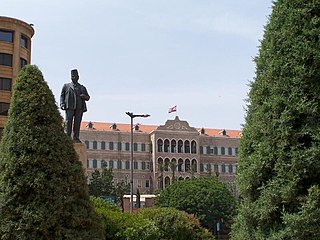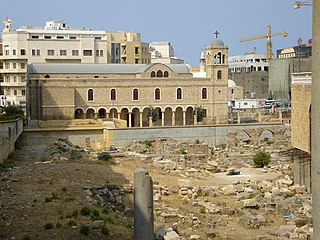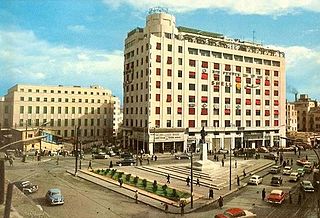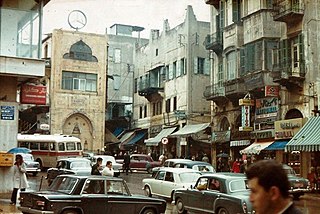
Cisterns of the Roman Baths are archaeological remains built during Roman times and are located in downtown Beirut, Lebanon. The cisterns were built in order to store and supply water to Roman Berytus. [1]

Cisterns of the Roman Baths are archaeological remains built during Roman times and are located in downtown Beirut, Lebanon. The cisterns were built in order to store and supply water to Roman Berytus. [1]
The Romans constructed an aqueduct fed by the Beirut River, whose main source was located 10 km (6.2 mi) from the city. When the water reached Riad Al Solh Square, it was stored in large cisterns and then distributed to the pools of the Roman Baths. The cisterns were built in order to store water for a city of nearly 50,000 inhabitants and in the Roman centuries this was a big engineering accomplishment.
For centuries, the streams and wells of Ain Naba’, Berjawi and Khandaq Al-Ghamiq provided Beirut with fresh water. At the time of Roman Berytus, four large bath complexes as well as numerous private baths increased the city’s water consumption.
The Romans constructed an aqueduct which crossed the river at Qanater Zbaydeh and followed the slopes of Hazmieh to Mar Mikhael and Furn Al-Chebak. The water finally reached Riad Al Solh Square; there, at the foot of the Serail Hill, it was stored in large cisterns. An intricate network of lead or clay pipes and channels distributed the water to the various pools of the Roman Baths.
The cisterns were damaged and partially destroyed during the big earthquake of 551 AD. Since then they were no more used.

Beirut is the capital and largest city of Lebanon. As of 2014, Greater Beirut has a population of 2.5 million, just under half of Lebanon's population, which makes it the fourth-largest city in the Levant region and the sixteenth-largest in the Arab world. The city is situated on a peninsula at the midpoint of Lebanon's Mediterranean coast. Beirut has been inhabited for more than 5,000 years, making it one of the oldest cities in the world.

Martyrs' Square, historically known as "Al Burj" or "Place des Cannons", is the historical central public square of Beirut, Lebanon.

The Grand Serail is the headquarters of the Prime Minister of Lebanon. It is situated atop a hill in downtown Beirut a few blocks away from the Lebanese Parliament building. The Grand Serail is a historic building, the most important of three Ottoman monuments on the Serail hill, the others being the Council for Development and Reconstruction and the Hamidiyyeh clock tower.

Berytus, briefly known as Laodicea in Phoenicia or Laodicea in Canaan from the 2nd century to 64 BCE, was the ancient city of Beirut from the Roman Republic through the Roman Empire and Early Byzantine period/late antiquity. Berytus became a Roman colonia that would be the center of Roman presence in the Eastern Mediterranean shores south of Anatolia.

The Beirut Central District is the historical and geographical core of Beirut, the capital of Lebanon. Also called downtown Beirut, it has been described as the “vibrant financial, commercial, and administrative hub of the country.” It is thousands of years old, with a traditional focus of business, finance, culture, and leisure.
Gaby Emile Layoun was the Lebanese Minister of Culture, announced as part of the cabinet led by Najib Mikati. He represents the Free Patriotic Movement. Layoun is married and has two children. He holds a diploma in engineering, a Lebanese Baccalaureate in mathematics (1982) and a Sacred Heart of the city of Zahle.

The architecture of Lebanon embodies the historical, cultural and religious influences that have shaped Lebanon's built environment. It has been influenced by the Phoenicians, Romans, Byzantines, Umayyads, Crusaders, Mamluks, Ottomans and French. Additionally, Lebanon is home to many examples of modern and contemporary architecture. Architecturally notable structures in Lebanon include ancient thermae and temples, castles, churches, mosques, hotels, museums, government buildings, souks, residences and towers.

The Saint Louis Cathedral of the Capuchin Fathers (French: Cathédrale Saint Louis des Pères Capucins) is a small Latin Catholic cathedral and convent in Beirut, Lebanon. It stands on the northern slope of the Serail Hill, adjacent to Bab Idris, one of Beirut’s seven historic city gates. The church was built by Capuchin missionaries in 1864, and named after King Louis IX of France who is venerated as a saint by the Catholic Church. The church is well known for its towering campanile.

The Zaghouan Aqueduct or Aqueduct of Carthage is an ancient Roman aqueduct, which supplied the city of Carthage, Tunisia with water. From its source in Zaghouan it flows a total of 132 km, making it among the longest aqueducts in the Roman Empire.

Beirut City Hall, also known as the Municipality of Beirut, is a landmark building built in downtown Beirut, Lebanon in 1924, and has become an architectural landmark in the downtown area of Beirut Central District. It features a yellow limestone facade and combines various architectural styles. The building is located on the intersection of Foch Street and Rue Weygand in the city center. The building is in the Venetian and Arabesque architectural styles, a mix that expresses the regional identity of the area.

Riad Al Solh Square is a square in the heart of downtown Beirut, Lebanon.

Bab Idriss Square is a square in downtown Beirut, Lebanon.

Cardo Decumanus Crossing was in the heart of Roman Berytus.

The Roman Berytus are located in the middle of downtown Beirut, Lebanon between Banks Street and Capuchin Street. The remains of a Roman bath of Berytus now surrounded by government buildings were found and conserved for posterity.

The Roman Forum is located in Beirut, Lebanon.

Colonnaded Street is located in downtown Beirut, Lebanon. it was an important street of Roman-era Berytus.
The Beirut Heritage Trail is a project undertaken by Solidere with the support of the Ministry of Culture and the Municipality of Beirut. Marked out by bronze medallions grouted into the sidewalk, the trail links archeological sites, historic public spaces and heritage buildings over a 2.5 km walking circuit in the historic core of Beirut.

The Cisterns of La Malga or Cisterns of La Mâalga are a group of cisterns, which are among the most visible features of the archaeological site of Carthage near Tunis, Tunisia. They are some of the best preserved Roman cisterns.
The hippodrome of Berytus was a circus in the Roman colony of Berytus. It is one of two hippodromes in Beirut.

Qalaat Faqra is an archaeological site in Kfardebian, Lebanon, with Roman and Byzantine ruins. Located near the Faqra ski resort on the slopes of Mount Sannine at an altitude of 1500 m, it is one of the most important sites of the UNESCO-listed valley of Nahr al-Kalb.